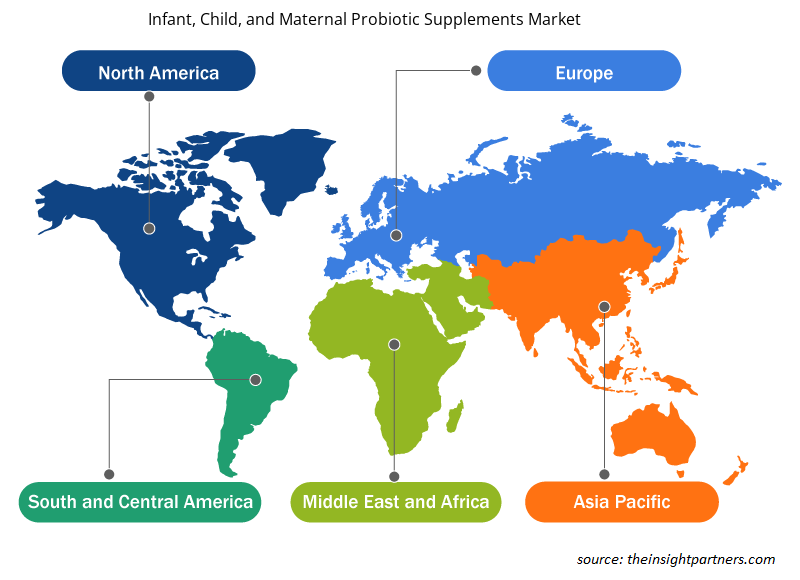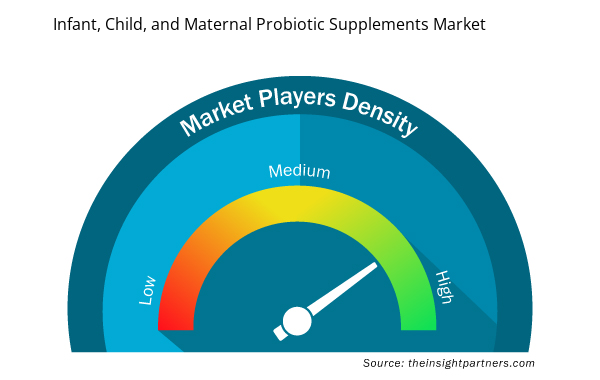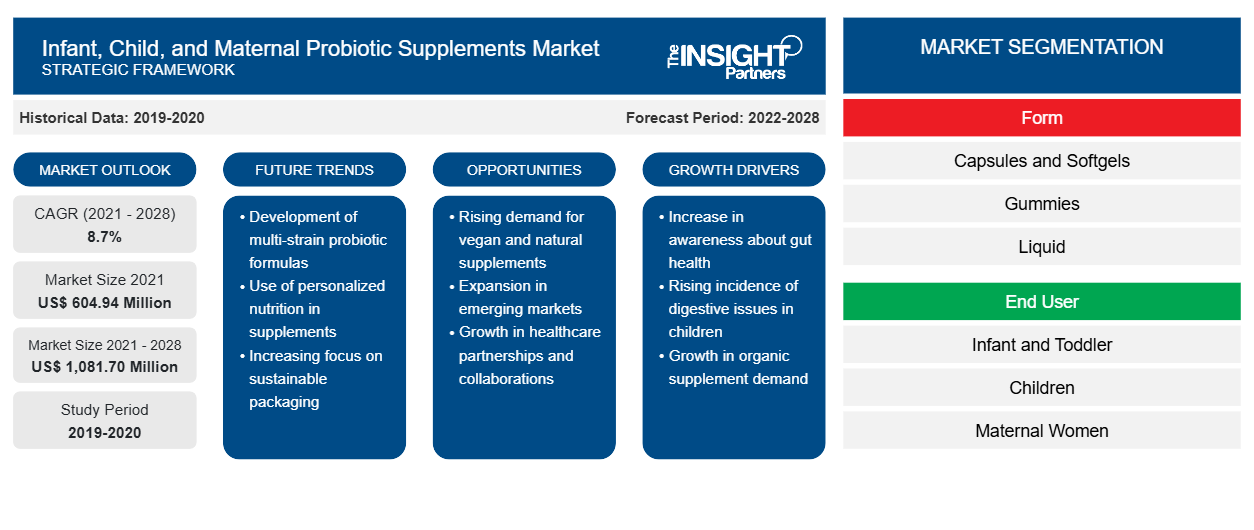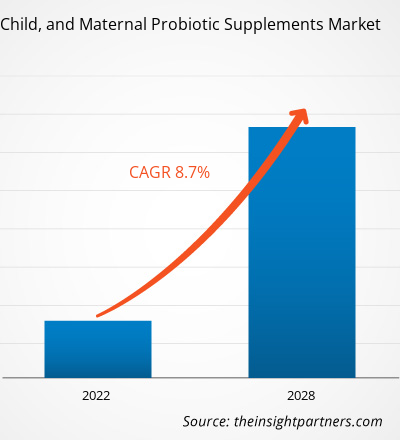Se proyecta que el mercado de suplementos probióticos para bebés, niños y madres alcance los 1.081,70 millones de dólares en 2028, frente a los 604,94 millones de dólares en 2021. Se espera que crezca a una CAGR del 8,7 % entre 2022 y 2028.probiotic supplements market is projected to reach US$ 1,081.70 million by 2028 from US$ 604.94 million in 2021. It is expected to grow at a CAGR of 8.7% from 2022 to 2028.
Los probióticos son bacterias vivas y/o levaduras que benefician la salud intestinal de la persona. Entre los diversos beneficios de los suplementos probióticos se incluyen el fortalecimiento del microbioma intestinal, la restauración del equilibrio del microbioma y el apoyo al sistema inmunológico. Dichos beneficios han hecho que su uso aumente entre el público objetivo, que incluye a bebés, niños y mujeres embarazadas. Los padres se centran cada vez más en la nutrición y el bienestar de sus hijos, lo que impulsa el mercado. Además, la creciente adopción de suplementos probióticos entre las mujeres embarazadas ha impulsado el mercado sustancialmente. La constante I+D que se lleva a cabo en esta categoría en todo el mundo impulsará el crecimiento del mercado en los próximos años.
En 2020, América del Norte tuvo la mayor participación del mercado mundial de suplementos probióticos para bebés, niños y madres , y se estima que Asia Pacífico registrará la CAGR más rápida durante el período de pronóstico. El aumento de la población, el desarrollo económico y el aumento de la renta disponible son algunos de los factores que contribuyen al crecimiento del mercado. La población de las economías emergentes, como India, China y Japón, está adoptando suplementos nutricionales para mejorar el crecimiento y el desarrollo de los niños. Además, el aumento de la tasa de mortalidad infantil en las economías emergentes ha impulsado la demanda de suplementos probióticos en la región. Por ejemplo, según el Banco Mundial, en 2020, la tasa de mortalidad infantil en Asia Oriental y el Pacífico fue de 11 por cada 1.000 nacidos vivos.
Personalice este informe según sus necesidades
Obtendrá personalización en cualquier informe, sin cargo, incluidas partes de este informe o análisis a nivel de país, paquete de datos de Excel, así como también grandes ofertas y descuentos para empresas emergentes y universidades.
- Obtenga las principales tendencias clave del mercado de este informe.Esta muestra GRATUITA incluirá análisis de datos, desde tendencias del mercado hasta estimaciones y pronósticos.
Impacto de la pandemia de COVID-19 en el mercado de suplementos probióticos para lactantes, niños y madres
Antes del inicio de la pandemia de COVID-19, el mercado de suplementos probióticos para bebés, niños y madres estaba impulsado principalmente por el creciente enfoque de los padres en la nutrición infantil específica y la creciente demanda de suplementos nutricionales adaptados a las necesidades de las mujeres embarazadas. Sin embargo, el mercado enfrentó desafíos sin precedentes después del brote en 2020. Los fabricantes de suplementos probióticos para bebés, niños y madres enfrentaron desafíos importantes debido a las limitaciones de la cadena de suministro causadas por los cierres nacionales, las prohibiciones comerciales y las restricciones de viaje. Las interrupciones de la cadena de suministro crearon una escasez de materias primas, lo que afectó la producción y distribución de varios productos, lo que provocó un aumento de los precios.probiotic supplements market was mainly driven by the rising focus of parents on specific infant nutrition and the increasing demand for nutritional supplements tailored according to the needs of pregnant women. However, the market faced unprecedented challenges after the outbreak in 2020. Manufacturers of infant, child, and maternal probiotic supplements faced significant challenges due to supply chain constraints caused by nationwide lockdowns, trade bans, and travel restrictions. Supply chain disruptions created a shortage of raw materials, which affected the production and distribution of various products, leading to increased prices.
En 2021, varias economías reanudaron sus operaciones a medida que los gobiernos anunciaban una flexibilización de las restricciones impuestas anteriormente, lo que impulsó el mercado mundial. Además, se permitió que las instalaciones de producción funcionaran a plena capacidad, lo que las ayudó a superar la brecha entre la demanda y la oferta y otras repercusiones. Como numerosos ciudadanos de muchos países estaban completamente vacunados en 2021, los actores del mercado se centraron en aumentar su producción para reactivar sus negocios.
Perspectivas del mercado
La creciente conciencia sobre los beneficios de los suplementos probióticos entre las mujeres embarazadas impulsará el mercado de suplementos probióticos para bebés, niños y madresProbiotic Supplements among Pregnant Women to Drive Infant, Child, and Maternal Probiotic Supplements Market
Los probióticos reducen el riesgo de preeclampsia en las mujeres embarazadas, una afección que provoca hipertensión arterial y niveles elevados de proteínas en la orina. Los suplementos probióticos también garantizan una mejor inmunidad para las mujeres embarazadas, lo que ayuda a combatir enfermedades crónicas y garantizar la buena salud del bebé. Lactobacillus acidophilus, Bifidobacterium bifidum y Saccharomyces boulardii se encuentran entre las cepas probióticas más eficaces y ampliamente utilizadas en los suplementos probióticos prenatales. Estas cepas ayudan a mantener una flora intestinal saludable y reducen el riesgo de diversas alergias, enfermedades y complicaciones, incluidas la diabetes gestacional y la preeclampsia. La creciente conciencia sobre los beneficios de los suplementos probióticos entre las mujeres embarazadas está impulsando sustancialmente el mercado de suplementos probióticos para bebés, niños y madres. lower the risk of pre-eclampsia in pregnant women, a health condition resulting in high blood pressure and high protein levels in urine. Probiotic supplements also ensure better immunity for pregnant women, which helps fight chronic diseases and ensure the baby's good health. Lactobacillus acidophilus, Bifidobacterium bifidum, and Saccharomyces boulardii are among the most effective and widely used probiotic strains in prenatal probiotic supplements. These strains help to maintain a healthy intestinal flora and reduce the risk of various allergies, diseases, and complications, including gestational diabetes and pre-eclampsia. The growing awareness about the benefits of probiotic supplements among pregnant women is substantially driving the infant, child, and maternal probiotic supplements market.
Información sobre formularios
Según la forma, el mercado de suplementos probióticos para bebés, niños y madres se clasifica en cápsulas y geles blandos, gomitas, líquidos y otros. El segmento otros tuvo la mayor participación en el mercado durante el período de pronóstico. Sin embargo, se espera que el segmento de gomitas registre la CAGR más alta durante el período de pronóstico. Las gomitas probióticas dulces y fáciles de consumir están disponibles en colores y formas atractivos (como ositos de peluche) y varios sabores. Varios fabricantes están involucrados en innovaciones de productos para satisfacer las crecientes demandas de adultos y niños. Es probable que estos desarrollos estratégicos de los fabricantes para diversificar su gama de productos impulsen la demanda de gomitas de suplementos probióticos para bebés, niños y madres en los próximos años.
Información para el usuario final
Según el usuario final, el mercado de suplementos probióticos para bebés, niños y madres está segmentado en bebés y niños pequeños, niños y mujeres embarazadas. El segmento de niños representó la mayor participación de mercado en 2020. Los suplementos probióticos están ganando popularidad en estos niños, ya que desempeñan un papel vital en el alivio de los cólicos, el estreñimiento agudo y el reflujo ácido. Algunos investigadores han demostrado que los probióticos pueden ayudar a prevenir la diarrea relacionada con los antibióticos en los niños, por lo que los pediatras a menudo incluyen suplementos probióticos al recetar antibióticos.
Entre los principales actores que operan en el mercado de suplementos probióticos para bebés, niños y madres se incluyen Bayer Corporation; Nestle SA; Mommy's Bliss Inc.; LoveBug Probiotics; BioGaia AB; MaryRuth Organics, LLC; Pharmavite LLC; Evolve Biosystems; Biomeology; y Nordic Naturals. Estas empresas están haciendo hincapié en los lanzamientos de nuevos productos y las expansiones geográficas para satisfacer la creciente demanda de los consumidores en todo el mundo. Tienen una amplia presencia global, lo que les permite atender a un gran conjunto de clientes de todo el mundo y, posteriormente, aumenta su participación de mercado. Estos actores del mercado se centran en gran medida en los lanzamientos de nuevos productos y las expansiones regionales para aumentar su gama de productos en carteras especializadas.
Perspectivas regionales del mercado de suplementos probióticos para lactantes, niños y madres
Los analistas de Insight Partners explicaron en detalle las tendencias y los factores regionales que influyen en el mercado de suplementos probióticos para bebés, niños y madres durante el período de pronóstico. Esta sección también analiza los segmentos y la geografía del mercado de suplementos probióticos para bebés, niños y madres en América del Norte, Europa, Asia Pacífico, Oriente Medio y África, y América del Sur y Central.

- Obtenga datos regionales específicos para el mercado de suplementos probióticos para lactantes, niños y madres
Alcance del informe de mercado sobre suplementos probióticos para lactantes, niños y madres
| Atributo del informe | Detalles |
|---|---|
| Tamaño del mercado en 2021 | US$ 604,94 millones |
| Tamaño del mercado en 2028 | US$ 1.081,70 millones |
| CAGR global (2021-2028) | 8,7% |
| Datos históricos | 2019-2020 |
| Período de pronóstico | 2022-2028 |
| Segmentos cubiertos | Por formulario
|
| Regiones y países cubiertos | América del norte
|
| Líderes del mercado y perfiles de empresas clave |
|
Densidad de actores del mercado de suplementos probióticos para lactantes, niños y madres: comprensión de su impacto en la dinámica empresarial
El mercado de suplementos probióticos para lactantes, niños y madres está creciendo rápidamente, impulsado por la creciente demanda de los usuarios finales debido a factores como la evolución de las preferencias de los consumidores, los avances tecnológicos y una mayor conciencia de los beneficios del producto. A medida que aumenta la demanda, las empresas amplían sus ofertas, innovan para satisfacer las necesidades de los consumidores y aprovechan las tendencias emergentes, lo que impulsa aún más el crecimiento del mercado.
La densidad de actores del mercado se refiere a la distribución de las empresas o firmas que operan dentro de un mercado o industria en particular. Indica cuántos competidores (actores del mercado) están presentes en un espacio de mercado determinado en relación con su tamaño o valor total de mercado.
Las principales empresas que operan en el mercado de suplementos probióticos para lactantes, niños y madres son:
- Corporación Bayer
- Nestlé SA
- Mami
Descargo de responsabilidad : Las empresas enumeradas anteriormente no están clasificadas en ningún orden particular.

- Obtenga una descripción general de los principales actores clave del mercado de suplementos probióticos para bebés, niños y madres
Informe Destacado
- Tendencias progresivas de la industria en el mercado de suplementos probióticos para bebés, niños y madres que ayudarán a las empresas a desarrollar estrategias efectivas a largo plazo
- Estrategias de crecimiento empresarial adoptadas por los actores del mercado de suplementos probióticos para lactantes, niños y madres en países desarrollados y en desarrollo
- Análisis cuantitativo del mercado de 2020 a 2028
- Estimación de la demanda mundial de ropa de trabajo
- Análisis de las cinco fuerzas de Porter para ilustrar la eficacia de los compradores y proveedores en el mercado de suplementos probióticos para lactantes, niños y madres
- Avances recientes para comprender el escenario competitivo del mercado
- Tendencias y perspectivas del mercado, así como factores que impulsan y restringen el crecimiento del mercado de suplementos probióticos para lactantes, niños y madres
- Asistencia en el proceso de toma de decisiones destacando las estrategias de mercado que sustentan el interés comercial.
- Tamaño del mercado de suplementos probióticos para lactantes, niños y madres en varios nodos
- Una descripción detallada y dinámica de la industria de ropa de trabajo
- Tamaño del mercado de suplementos probióticos para lactantes, niños y madres en varias regiones con oportunidades de crecimiento prometedoras
- Análisis histórico (2 años), año base, pronóstico (7 años) con CAGR
- Análisis PEST y FODA
- Tamaño del mercado Valor/volumen: global, regional, nacional
- Industria y panorama competitivo
- Conjunto de datos de Excel



Report Coverage
Revenue forecast, Company Analysis, Industry landscape, Growth factors, and Trends

Segment Covered
This text is related
to segments covered.

Regional Scope
North America, Europe, Asia Pacific, Middle East & Africa, South & Central America

Country Scope
This text is related
to country scope.
Preguntas frecuentes
Of late, parents have become more concerned about specific nutrition for their children to ensure proper growth and development. According to the World Health Organization (WHO), providing proper nutrition to babies in their first 3 years can reduce mortality and morbidity in them, decrease the risk of chronic diseases throughout their lifetime, and promote regular mental and physical growth. The poor nutrition of infants can cause serious health issues, including stunted growth and malnutrition. Additionally, poor nutrition during the first 3 months of a baby's life can increase the risk of death. However, the rise in awareness regarding proper infant nutrition among parents has reduced the infant mortality rate. Therefore, increase in awareness regarding such nutritional intake has surged the demand for infant, child, and maternal probiotic supplements market.
Based on the end user, maternal women segment is projected to grow at the fastest CAGR over the forecast period. Probiotic supplements are gaining popularity among pregnant women owing to their role in reducing the risk of eczema in babies, lessening complications associated with childbirth, and improving the metabolic health of expectant mothers. Women experience dramatic changes in physiology and immune systems during pregnancy, including alterations in the gut microbiome population. These issues can be addressed using probiotic supplements. Probiotic supplements help pregnant women in gaining weight.
North America accounted for the largest share of the global workwear market. North America is one of the most significant regions for the infant, child, and maternal probiotic supplements market due to the increasing awareness about the benefits offered by probiotic supplements in infants, children, and pregnant women. Parents in the region are more concerned about their children's development and growth. Some common health conditions observed in the region include allergies, asthma, urinary tract infection, colic in infants, and autism. According to the Allergy & Asthma Foundation of Asthma, in 2018, approximately 5.2 thousand children in the US were diagnosed with seasonal allergic rhinitis. Increasing health issues among children have concerned parents, which in turn, has resulted in the uptake of probiotic supplements.
Based on form, others segment mainly has the largest revenue share. The other forms in the segment include powder, tablets, chewable tablets, effervescent tablets, lozenges, and quick dissolvable formats. The growth is attributed by increasing use of these forms owing to their various benefits such as longer shelf life and physiochemical stability of powder, inexpensive, more effective, and among others. Moreover, such benefits offered by this form have surged manufacturers to in launching probiotic supplements in various forms such as lozenges.
The major players operating in the global infant, child, and maternal probiotic supplements market are Bayer Corporation; Nestle S.A.; Mommy’s Bliss Inc.; LoveBug Probiotics; Biogaia AB; MaryRuth Organics, LLC; Pharmavite LLC; Evolve Biosystems; Biomeology; and Nordic Naturals.
Infant nutrition is one of the most lucrative markets in Asia Pacific. The rising population, steady economic development, and increase in per capita income are some of the major factors driving the infant nutrition market. People in countries such as China, India, and South Korea are highly concerned about their children's health and wellbeing and are widely adopting dietary supplements that support their growth and development. Infant probiotic supplements are also gaining significant traction, owing to children and infants' rising focus on digestive health and immunity. Thus, the rising demand for infant probiotic supplements in developing markets is expected to provide lucrative growth opportunities over the forecast period.
Trends and growth analysis reports related to Consumer Goods : READ MORE..
The List of Companies - Infant, Child, and Maternal Probiotic Supplements Market
- Bayer Corporation
- Nestle S.A.
- Mommy’s Bliss Inc.
- LoveBug Probiotics
- Biogaia AB
- MaryRuth Organics, LLC
- Pharmavite LLC
- Evolve Biosystems
- Biomeology
- Nordic Naturals
The Insight Partners performs research in 4 major stages: Data Collection & Secondary Research, Primary Research, Data Analysis and Data Triangulation & Final Review.
- Data Collection and Secondary Research:
As a market research and consulting firm operating from a decade, we have published and advised several client across the globe. First step for any study will start with an assessment of currently available data and insights from existing reports. Further, historical and current market information is collected from Investor Presentations, Annual Reports, SEC Filings, etc., and other information related to company’s performance and market positioning are gathered from Paid Databases (Factiva, Hoovers, and Reuters) and various other publications available in public domain.
Several associations trade associates, technical forums, institutes, societies and organization are accessed to gain technical as well as market related insights through their publications such as research papers, blogs and press releases related to the studies are referred to get cues about the market. Further, white papers, journals, magazines, and other news articles published in last 3 years are scrutinized and analyzed to understand the current market trends.
- Primary Research:
The primarily interview analysis comprise of data obtained from industry participants interview and answers to survey questions gathered by in-house primary team.
For primary research, interviews are conducted with industry experts/CEOs/Marketing Managers/VPs/Subject Matter Experts from both demand and supply side to get a 360-degree view of the market. The primary team conducts several interviews based on the complexity of the markets to understand the various market trends and dynamics which makes research more credible and precise.
A typical research interview fulfils the following functions:
- Provides first-hand information on the market size, market trends, growth trends, competitive landscape, and outlook
- Validates and strengthens in-house secondary research findings
- Develops the analysis team’s expertise and market understanding
Primary research involves email interactions and telephone interviews for each market, category, segment, and sub-segment across geographies. The participants who typically take part in such a process include, but are not limited to:
- Industry participants: VPs, business development managers, market intelligence managers and national sales managers
- Outside experts: Valuation experts, research analysts and key opinion leaders specializing in the electronics and semiconductor industry.
Below is the breakup of our primary respondents by company, designation, and region:

Once we receive the confirmation from primary research sources or primary respondents, we finalize the base year market estimation and forecast the data as per the macroeconomic and microeconomic factors assessed during data collection.
- Data Analysis:
Once data is validated through both secondary as well as primary respondents, we finalize the market estimations by hypothesis formulation and factor analysis at regional and country level.
- Macro-Economic Factor Analysis:
We analyse macroeconomic indicators such the gross domestic product (GDP), increase in the demand for goods and services across industries, technological advancement, regional economic growth, governmental policies, the influence of COVID-19, PEST analysis, and other aspects. This analysis aids in setting benchmarks for various nations/regions and approximating market splits. Additionally, the general trend of the aforementioned components aid in determining the market's development possibilities.
- Country Level Data:
Various factors that are especially aligned to the country are taken into account to determine the market size for a certain area and country, including the presence of vendors, such as headquarters and offices, the country's GDP, demand patterns, and industry growth. To comprehend the market dynamics for the nation, a number of growth variables, inhibitors, application areas, and current market trends are researched. The aforementioned elements aid in determining the country's overall market's growth potential.
- Company Profile:
The “Table of Contents” is formulated by listing and analyzing more than 25 - 30 companies operating in the market ecosystem across geographies. However, we profile only 10 companies as a standard practice in our syndicate reports. These 10 companies comprise leading, emerging, and regional players. Nonetheless, our analysis is not restricted to the 10 listed companies, we also analyze other companies present in the market to develop a holistic view and understand the prevailing trends. The “Company Profiles” section in the report covers key facts, business description, products & services, financial information, SWOT analysis, and key developments. The financial information presented is extracted from the annual reports and official documents of the publicly listed companies. Upon collecting the information for the sections of respective companies, we verify them via various primary sources and then compile the data in respective company profiles. The company level information helps us in deriving the base number as well as in forecasting the market size.
- Developing Base Number:
Aggregation of sales statistics (2020-2022) and macro-economic factor, and other secondary and primary research insights are utilized to arrive at base number and related market shares for 2022. The data gaps are identified in this step and relevant market data is analyzed, collected from paid primary interviews or databases. On finalizing the base year market size, forecasts are developed on the basis of macro-economic, industry and market growth factors and company level analysis.
- Data Triangulation and Final Review:
The market findings and base year market size calculations are validated from supply as well as demand side. Demand side validations are based on macro-economic factor analysis and benchmarks for respective regions and countries. In case of supply side validations, revenues of major companies are estimated (in case not available) based on industry benchmark, approximate number of employees, product portfolio, and primary interviews revenues are gathered. Further revenue from target product/service segment is assessed to avoid overshooting of market statistics. In case of heavy deviations between supply and demand side values, all thes steps are repeated to achieve synchronization.
We follow an iterative model, wherein we share our research findings with Subject Matter Experts (SME’s) and Key Opinion Leaders (KOLs) until consensus view of the market is not formulated – this model negates any drastic deviation in the opinions of experts. Only validated and universally acceptable research findings are quoted in our reports.
We have important check points that we use to validate our research findings – which we call – data triangulation, where we validate the information, we generate from secondary sources with primary interviews and then we re-validate with our internal data bases and Subject matter experts. This comprehensive model enables us to deliver high quality, reliable data in shortest possible time.


 Obtenga una muestra gratuita de este informe
Obtenga una muestra gratuita de este informe